Magnitude 7.33 Apparent magnitude (V) 7.33 | ||
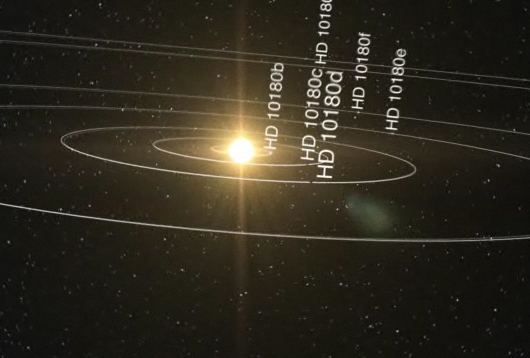 | ||
Similar Kepler‑11, 55 Cancri, HD 40307, Gliese 876, Kepler‑90 | ||
Hd 10180 richest planetary system discovered
HD 10180 is a Sun-like star in the southern constellation Hydrus that is notable for its large planetary system. Since its discovery, at least seven planets, and possibly as many as nine, have been observed orbiting it, making it the largest known exoplanetary system in terms of total confirmed planets (significantly larger than previous record holders, Kepler-11 and 55 Cancri) and potentially the largest of all known planetary systems, including the Solar System.
Contents
- Hd 10180 richest planetary system discovered
- Animation of the planetary system around sun like star hd 10180
- Characteristics
- Planetary system
- Orbital arrangement
- Planets
- References
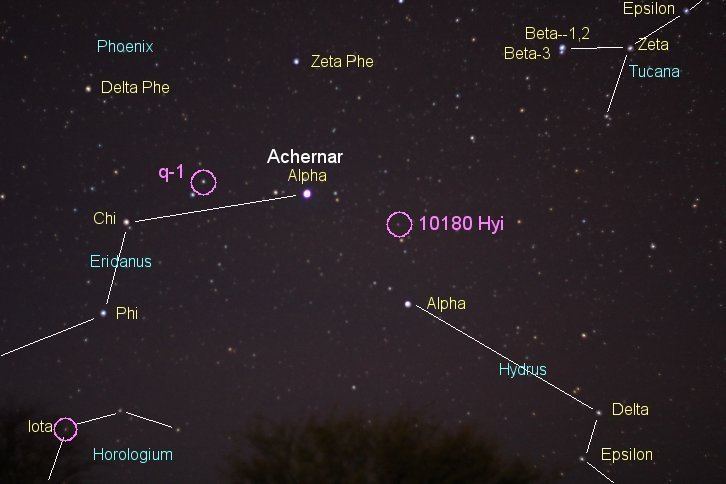
Animation of the planetary system around sun like star hd 10180
Characteristics
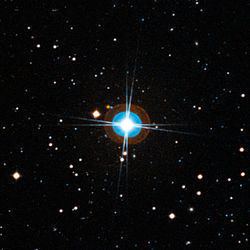
Based upon parallax measurements, it is located at a distance of about 127 light-years (39 parsecs) from Earth. The apparent visual magnitude of this star is 7.33, which is too faint to be viewed with the naked eye although it can be readily observed with a small telescope. At a declination of −60°, this star cannot be seen at latitudes north of the tropics.
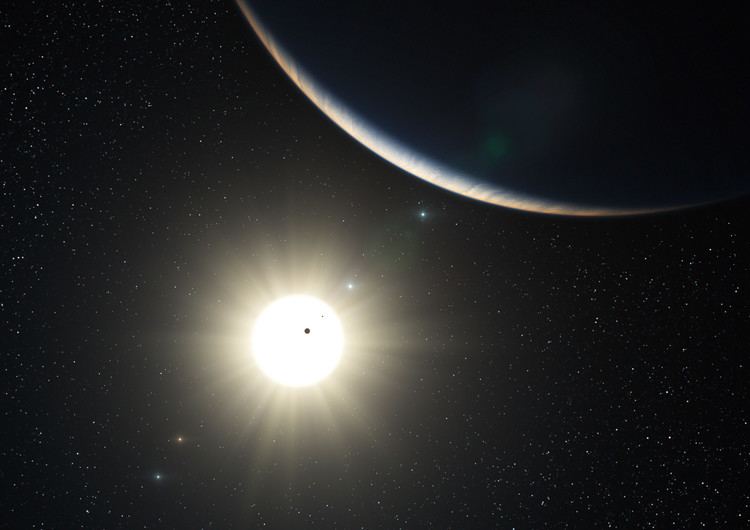
HD 10180 is a G1V-type star, and thus generates energy at its core through the thermonuclear fusion of hydrogen. The mass of this star is estimated as 6% greater than the Sun's mass, it has a radius of 120% that of the Sun, and is radiating 149% of the Sun's luminosity. The effective temperature of the star's chromosphere is 5,911 K, giving it a yellow-hued glow like the Sun. HD 10180 has a 20% higher abundance of elements other than hydrogen/helium compared to the Sun. With an estimated age of 7.3 billion years, it is a stable star with no significant magnetic activity. The estimated period of rotation is about 24 days.
Planetary system
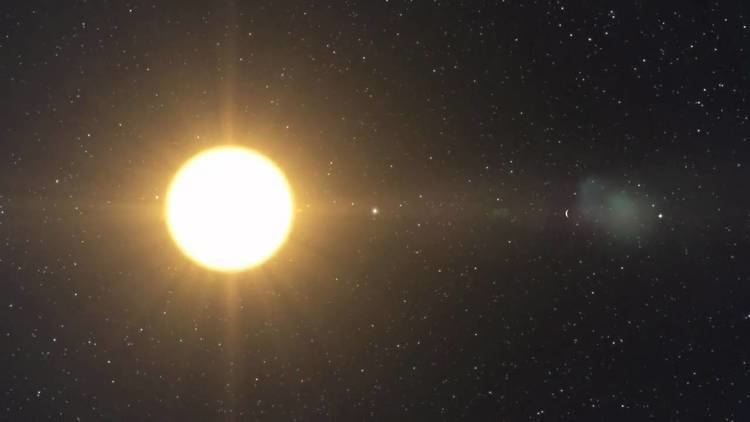
On August 24, 2010, a research team led by Christophe Lovis of the University of Geneva announced that the star has at least five planets, and possibly as many as seven. The planets were detected using the HARPS spectrograph, in conjunction with the ESO's 3.6 m telescope at La Silla Observatory in Chile, using Doppler spectroscopy.
On April 5, 2012, astronomer Mikko Tuomi of the University of Hertfordshire submitted a paper to Astronomy and Astrophysics approved for publishing on the April 6, 2012 that proposed a nine planet model for the system. Re-analysing the data using Bayesian probability analysis, previously known planets' parameters were revised and further evidence was found for the innermost planet (b) as well as evidence of two additional planets (i and j).
The system is not known to be a transiting planetary system and as such planets are unlikely to be detected or verified by the transit method.
Orbital arrangement
The system contains five planets with minimum masses from 12 to 25 times Earth's (comparable to the mass of Uranus and Neptune) at orbital radii of 0.06, 0.13, 0.27, 0.49 and 1.42 AU just short of that of Mars.
There are no planets known to be in mean-motion resonances, although it has a number of near resonances including 3c:2i:1d and 3e:2j:1f. The approximate ratios of periods of adjacent orbits are (proceeding outward): 1:5, 1:3, 1:3, 2:5, 1:5, 3:11.
Since the inclination of the planets' orbits is unknown, only minimum planetary masses can presently be obtained. Dynamical simulations suggest that the system cannot be stable if the true masses of the planets exceed the minimum masses by a factor of greater than three (corresponding to an inclination of less than 20°, where 90° is edge-on).
Planets
HD 10180 b is a possible Earth-sized planet (minimum mass 1.4 times Earth's) located at 0.02 AU. Its orbital radius was originally estimated to have a near circular orbit at a distance of 0.02225 ± 0.00035 AU (closer than Mercury, about one seventh the distance and correspondingly hotter), taking 1.1 days to complete a full orbit. Planet b was confirmed in 2012 with a slightly smaller orbital radius and a more eccentric orbit. The false detection probability was initially 1.4%; however, its probability was firmed by Mikko Tuomi in 2012.
HD 10180 c, with a minimum mass comparable to that of Uranus, is a hot Neptune. Dynamical simulations suggest that if the mass gradient was any more than a factor of two, the system would not be stable. Planet c's orbital period and eccentricity were originally estimated at 5.75979 ± 0.00062 and 0.045 ± 0.026 respectively; however, these were revised in 2012 in favour of a more eccentric orbit. The false detection probability is less than 0.1%.
HD 10180 i is a possible but unconfirmed hot super-Earth discovered by Mikko Tuomi in 2012.
HD 10180 d is a hot Neptune. Its mass was initially estimated at >11.75 ± 0.65 (smaller than Uranus) and on a slightly eccentric orbit; however, this was re-estimated with a larger mass and less eccentric orbit in 2012.
HD 10180 e is also a hot Neptune with about twice the mass of Neptune. Its estimated orbital distance and eccentricity were downscaled in 2012. The false detection probability is less than 0.1%.
HD 10180 j is a possible but unconfirmed hot super-Earth or gas dwarf discovered by Mikko Tuomi in 2012.
HD 10180 f is a hot Neptune and of similar in mass to HD 10180 e. At orbital distance of 0.49AU and eccentricity of 0.13, its tight and wild orbit is analoguous to that of Mercury with a similar black-body-temperature range though with its immense mass, any greenhouse effect caused by an atmosphere would give it searing Venus-like or greater temperatures. Estimated orbital distance and eccentricity were downscaled slightly in 2012. The false detection probability is less than 0.1%.
HD 10180 g is a giant planet with a mass larger than Neptune's. It has a fairly circular orbit at 1.4 AU and therefore fully within the system's predicted habitable zone though it does not fit the current models for planetary habitability due to its large mass (24 times Earth). If it is a gas giant, it is likely of Sudarsky Class II. There is a possibility that a natural satellite with sufficient atmospheric pressure could have liquid water on its surface. Its estimated orbital distance and eccentricity were downscaled in 2012 but remains in the habitable zone. The false detection probability is less than 0.1%.
HD 10180 h is the largest and outermost known planet in the system. It is likely a Saturn-sized giant planet with a minimum mass 65 times that of Earth. Orbiting at 3.4 AU, a distance comparable to the distance of the outer part of the asteroid belt from the Sun and as such it is likely a Sudarsky Class I planet. The spurious detection probability is 0.6%.
